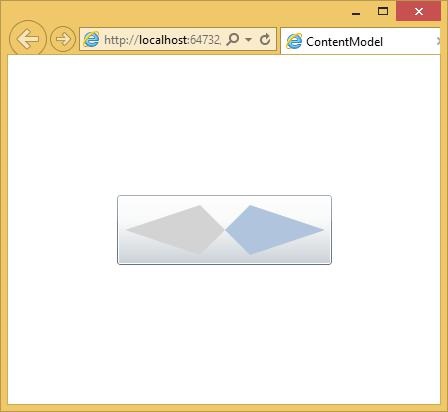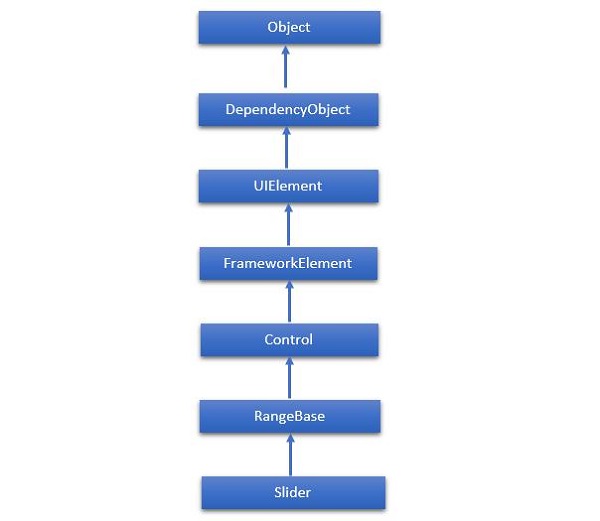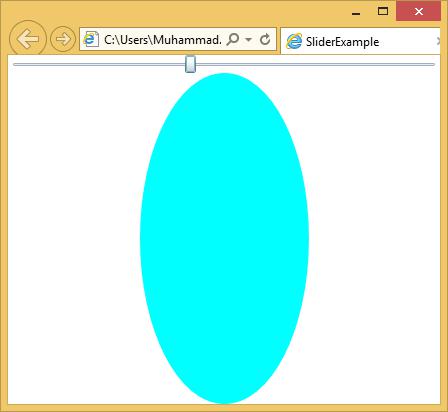Silverlight - 内容模型
这些按钮为模型内容提供了一种形式的内容。 模型在控件中大量出现。 这个想法很简单。 它将接受任何内容而不仅仅是文本。 如果您想创建一个真正奇特的按钮,您甚至可以在其中放置其他内容控件,例如文本框和按钮(并在其中嵌套静态元素)。 这样的界面是否有意义值得怀疑,但它是可能的。
让我们看一个带有按钮的简单示例,按钮内有其他内容控件。
<UserControl x:Class = "ContentModel.MainPage"
xmlns = "http://schemas.microsoft.com/winfx/2006/xaml/presentation"
xmlns:x = "http://schemas.microsoft.com/winfx/2006/xaml"
xmlns:d = "http://schemas.microsoft.com/expression/blend/2008"
xmlns:mc = "http://schemas.openxmlformats.org/markup-compatibility/2006"
mc:Ignorable = "d"
d:DesignHeight = "300" d:DesignWidth = "400">
<Grid x:Name = "LayoutRoot" Background = "White">
<Button Margin = "3" Height = "70" Width = "215">
<Grid Margin = "5">
<Polygon Points = "100,25 125,0 200,25 125,50" Fill = "LightSteelBlue" />
<Polygon Points = "100,25 75,0 0,25 75,50" Fill = "LightGray"/>
</Grid>
</Button>
</Grid>
</UserControl>
当上面的代码编译并执行后,您将看到以下按钮。

范围控件
滚动条和滑块控件密切相关。 它们都允许用户从特定范围中选择输入值。 按照惯例,这些控件代表不同的事物。 滚动条通常用于将位置设置到阴囊区域,而滑块用于指定某些值或设置。 这些只是惯例; 这些控件具有类似的行为和 API。
范围控件易于使用。 您指定最小值和最大值来指示您希望滑块表示的值的范围。 Value 属性会随着拖动的使用情况的不同而变化。
Slider类的层次继承如下−

下面给出了Slider常用的属性。
| Sr. No. | 属性和描述 |
|---|---|
| 1 | Header 获取或设置控件标头的内容。 |
| 2 | HeaderProperty 标识标头依赖属性。 |
| 3 | HeaderTemplate 获取或设置用于显示控件标头内容的 DataTemplate。 |
| 4 | HeaderTemplateProperty 标识 HeaderTemplate 依赖属性。 |
| 5 | IntermediateValue 在用户与滑块交互时,在该值捕捉到刻度值或步长值之前,获取或设置滑块的值。 SnapsTo 属性指定滑块的值。 |
| 6 | IntermediateValueProperty 标识 IntermediateValue 依赖属性。 |
| 7 | IsDirectionReversed 获取或设置一个指示值增加方向的值。 |
| 8 | IsDirectionReversedProperty 标识 IsDirectionReversed 依赖属性。 |
| 9 | IsThumbToolTipEnabled 获取或设置一个值,该值确定滑块值是否显示在滑块的 Thumb 组件的工具提示中。 |
| 10 | IsThumbToolTipEnabledProperty 标识 IsThumbToolTipEnabled 依赖属性。 |
| 11 | Orientation 获取或设置滑块的方向。 |
| 12 | OrientationProperty 标识方向依赖属性。 |
| 13 | StepFrequency 获取或设置应为其创建步骤的值范围的值部分。 |
| 14 | StepFrequencyProperty 标识 StepFrequency 依赖属性。 |
| 15 | ThumbToolTipValueConverter 获取或设置将 Slider 的范围值转换为工具提示内容的转换器逻辑。 |
| 16 | ThumbToolTipValueConverterProperty 标识 ThumbToolTipValueConverter 依赖属性。 |
| 17 | TickFrequency 获取或设置应为其创建刻度的值范围的增量。 |
| 18 | TickFrequencyProperty 标识 TickFrequency 依赖属性。 |
| 19 | TickPlacement 获取或设置一个值,该值指示在何处绘制与轨道相关的刻度线。 |
| 20 | TickPlacementProperty 标识 TickPlacement 依赖属性。 |
下面给出的是Slider类中常用的事件。
| Sr. No. | 事件和描述 |
|---|---|
| 1 | ManipulationCompleted 在 UIElement 上的操作完成时发生。 (继承自UIElement) |
| 2 | ManipulationDelta 当输入设备在操作期间改变位置时发生。 (继承自UIElement) |
| 3 | ManipulationInertiaStarting 当输入设备在操作期间失去与 UIElement 对象的接触并且惯性开始时发生。 (继承自UIElement) |
| 4 | ManipulationStarted 当输入设备开始对 UIElement 进行操作时发生。 (继承自UIElement) |
| 5 | ManipulationStarting 首次创建操作处理器时发生。 (继承自UIElement) |
| 6 | ValueChanged 当范围值更改时发生。 (继承自RangeBase) |
下面给出了Slider类中常用的方法。
| Sr. No. | 方法及说明 |
|---|---|
| 1 | OnManipulationCompleted 在 ManipulationCompleted 事件发生之前调用。 (继承自Control) |
| 2 | OnManipulationDelta 在 ManipulationDelta 事件发生之前调用。 (继承自Control) |
| 3 | OnManipulationInertiaStarting 在 ManipulationInertiaStarting 事件发生之前调用。 (继承自Control) |
| 4 | OnManipulationStarted 在 ManipulationStarted 事件发生之前调用。 (继承自Control) |
| 5 | OnManipulationStarting 在 ManipulationStarting 事件发生之前调用。 (继承自Control) |
| 6 | OnMaximumChanged 当 Maximum 属性更改时调用。 (继承自RangeBase) |
| 7 | OnMinimumChanged 当Minimum 属性更改时调用。 (继承自RangeBase) |
| 8 | OnValueChanged 触发 ValueChanged 路由事件。 (继承自RangeBase) |
| 9 | SetBinding 使用提供的绑定对象将绑定附加到 FrameworkElement。 (继承自FrameworkElement) |
| 10 | SetValue 设置 DependencyObject 上的依赖属性的本地值。 (继承自DependencyObject) |
示例
让我们看一个简单的例子,其中添加了滑块和椭圆,滑块控制椭圆的宽度。
<UserControl x:Class = "SliderExample.MainPage"
xmlns = "http://schemas.microsoft.com/winfx/2006/xaml/presentation"
xmlns:x = "http://schemas.microsoft.com/winfx/2006/xaml"
xmlns:d = "http://schemas.microsoft.com/expression/blend/2008" xmlns:mc = "
http://schemas.openxmlformats.org/markup-compatibility/2006"
mc:Ignorable = "d" d:DesignWidth = "640" d:DesignHeight = "480">
<Grid x:Name = "LayoutRoot">
<Grid.RowDefinitions>
<RowDefinition Height = "Auto" />
<RowDefinition />
</Grid.RowDefinitions>
<Slider Minimum = "1" Maximum = "400" Value = "1"
ValueChanged = "Slider_ValueChanged" />
<Ellipse Grid.Row = "1" Fill = "Aqua" Width = "1" x:Name = "myEllipse" />
</Grid>
</UserControl>
下面给出的是值更改事件的 C# 实现。
using System.Windows;
using System.Windows.Controls;
namespace SliderExample {
public partial class MainPage : UserControl {
public MainPage() {
InitializeComponent();
}
private void Slider_ValueChanged(object sender,
RoutedPropertyChangedEventArgs<double> e) {
if (myEllipse != null) {
myEllipse.Width = e.NewValue;
}
}
}
}
编译并执行上述代码后,您将看到以下输出。 正如您所看到的,当您从左向右移动滑块时,椭圆宽度会增加。



